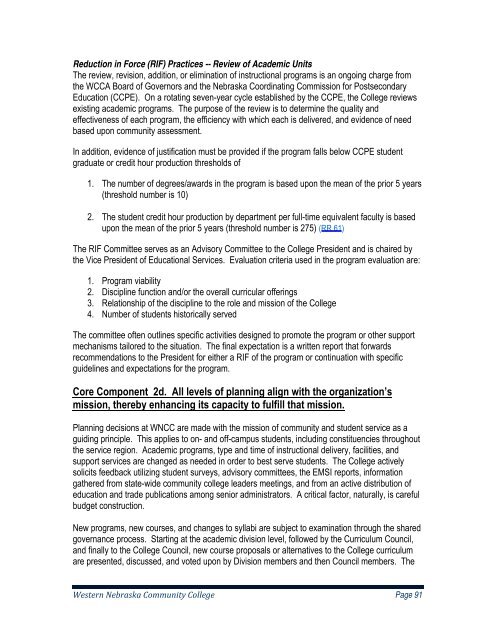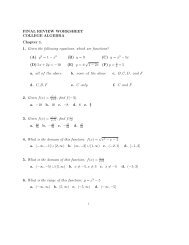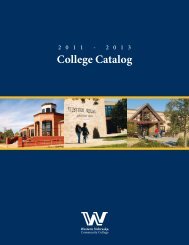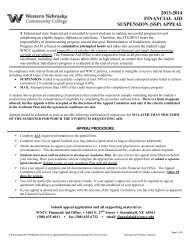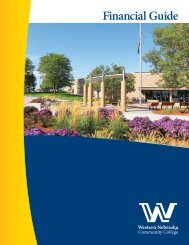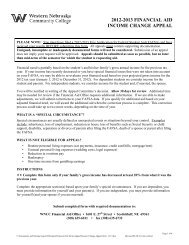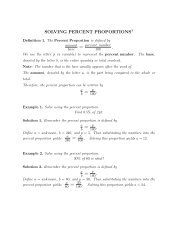WNCC 2010 Self-Study Report - Western Nebraska Community ...
WNCC 2010 Self-Study Report - Western Nebraska Community ...
WNCC 2010 Self-Study Report - Western Nebraska Community ...
Create successful ePaper yourself
Turn your PDF publications into a flip-book with our unique Google optimized e-Paper software.
Reduction in Force (RIF) Practices -- Review of Academic Units<br />
The review, revision, addition, or elimination of instructional programs is an ongoing charge from<br />
the WCCA Board of Governors and the <strong>Nebraska</strong> Coordinating Commission for Postsecondary<br />
Education (CCPE). On a rotating seven-year cycle established by the CCPE, the College reviews<br />
existing academic programs. The purpose of the review is to determine the quality and<br />
effectiveness of each program, the efficiency with which each is delivered, and evidence of need<br />
based upon community assessment.<br />
In addition, evidence of justification must be provided if the program falls below CCPE student<br />
graduate or credit hour production thresholds of<br />
1. The number of degrees/awards in the program is based upon the mean of the prior 5 years<br />
(threshold number is 10)<br />
2. The student credit hour production by department per full-time equivalent faculty is based<br />
upon the mean of the prior 5 years (threshold number is 275) (RR 61)<br />
The RIF Committee serves as an Advisory Committee to the College President and is chaired by<br />
the Vice President of Educational Services. Evaluation criteria used in the program evaluation are:<br />
1. Program viability<br />
2. Discipline function and/or the overall curricular offerings<br />
3. Relationship of the discipline to the role and mission of the College<br />
4. Number of students historically served<br />
The committee often outlines specific activities designed to promote the program or other support<br />
mechanisms tailored to the situation. The final expectation is a written report that forwards<br />
recommendations to the President for either a RIF of the program or continuation with specific<br />
guidelines and expectations for the program.<br />
Core Component 2d. All levels of planning align with the organization’s<br />
mission, thereby enhancing its capacity to fulfill that mission.<br />
Planning decisions at <strong>WNCC</strong> are made with the mission of community and student service as a<br />
guiding principle. This applies to on- and off-campus students, including constituencies throughout<br />
the service region. Academic programs, type and time of instructional delivery, facilities, and<br />
support services are changed as needed in order to best serve students. The College actively<br />
solicits feedback utilizing student surveys, advisory committees, the EMSI reports, information<br />
gathered from state-wide community college leaders meetings, and from an active distribution of<br />
education and trade publications among senior administrators. A critical factor, naturally, is careful<br />
budget construction.<br />
New programs, new courses, and changes to syllabi are subject to examination through the shared<br />
governance process. Starting at the academic division level, followed by the Curriculum Council,<br />
and finally to the College Council, new course proposals or alternatives to the College curriculum<br />
are presented, discussed, and voted upon by Division members and then Council members. The<br />
<strong>Western</strong> <strong>Nebraska</strong> <strong>Community</strong> College Page 91


